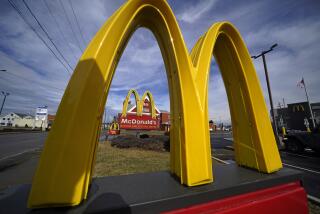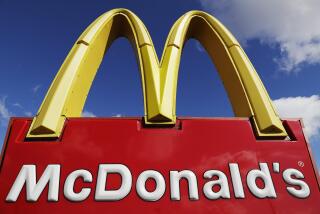McDonald’s pushes ahead with new look
Reporting from Chicago — With half-moon-shaped booths, low stools, wooden blinds and flat-screen TVs, most patrons might expect to pay $8 for a burger, or $4 for a smoothie. But the decor isn’t a harbinger of price. This is the new look of a remodeled McDonald’s, purveyor of Happy Meals and value deals as well as upscale coffee drinks.
The Oak Brook, Ill.-based burger chain is reaching critical mass on a nearly decade-long, multibillion-dollar global renovation and rebuilding project it’s betting will boost sales, traffic and brand perception. Restaurants undergoing simultaneous interior and exterior remodels are expected to see a 6% to 7% increase in same-store sales upon reopening, no matter where they are located.
“We are playing a little bit of catch-up,” said Denis Weil, McDonald’s vice president of concept and design, adding that retail remodels now need to happen more frequently. “Styles change faster, and customers have a higher need for novelty, and their tastes change faster as well.”
Once an area has reached 40% to 60% completion in the remodeling process, Weil said, consumers begin to view the brand differently, stop in more often and buy higher-end items. Analysts say that at that point they can also see the lift in sales.
McDonald’s plans to open 1,300 restaurants and remodel 2,400 in 2012, spending about $2.9 billion. The chain pays 40% to 45% of a franchisee’s remodeling costs for each restaurant, which averages about $600,000 in the U.S. By year-end, the chain will have completed interior renovations on about half its 33,000 restaurants worldwide.
“We believe now is an opportune time to strategically increase new store openings while continuing a significant focus on reimaging,” McDonald’s Chief Financial Officer Pete Bensen said. “We have the financial capacity and talent to invest when many others cannot.”
Although McDonald’s is on a nearly nine-year streak of global same-store sales gains — most recently reporting a surge of 7.5% during the fourth quarter of 2011 — some fast-casual restaurants such as Chipotle and Panera are posting similar or greater gains. By adopting a higher-end look, McDonald’s is seeking to gain broader acceptance for top-tier items already on the menu, like smoothies and Angus burgers, and better compete with the fast-casual industry.
“The evolution of the McDonald’s brand is, I think, necessary because so many other fast-casual brands are growing up,” said Darren Tristano, executive vice president of Technomic, a Chicago-based food industry consulting firm. He added that McDonald’s has done well to offer more premium products, particularly with drinks such as smoothies and specialty coffees.
In the U.S., bright red, double mansard roofs are being swapped for a single yellow arch outside; inside, two- and four-top tables are being swapped for long, wide community tables, tall bar tables and more modern booths. About 33% of the chain’s 14,098 U.S. units have undergone an interior face lift, and only 16% have completed an exterior overhaul.
Weil said cultural tastes have necessitated different exterior designs around the world. But needs inside the restaurants are more common. On the inside, he said, major metropolitan areas like London, New York and Shanghai share a similar look, distinct from suburban or rural areas.
The company is moving to seating “zones”: slow zones for coffee sippers enjoying the Wi-Fi, fast zones at high bar tables for single diners wolfing down a sandwich, and family zones with booths for parents to “lock” their children on the inside to prevent them from wandering.
“We have clear standards around the world,” Weil said. “The design might be different, but we have standards — sleek tables and chairs, contemporary graphics, variable lighting, timeless base materials, seating zones, flexible seating, open floor plans and clean upgraded restrooms — so these are all things you will see in all of the decors.”
Morningstar analyst R.J. Hottovy said McDonald’s rationale for the investment has been evident in the chain’s numbers for areas of the world with a significant number of remodels. He added that the remodels are making restaurants “more inviting to customers,” not just because of the upgraded look but also because of added features such as Wi-Fi and flat-screen TVs.
Weil said the updates also help the chain sell more of its higher-end items.
“It’s about permission,” Weil said. “As [President] Don Thompson says, ‘You eat with your eyes first.’”
More to Read
Inside the business of entertainment
The Wide Shot brings you news, analysis and insights on everything from streaming wars to production — and what it all means for the future.
You may occasionally receive promotional content from the Los Angeles Times.










